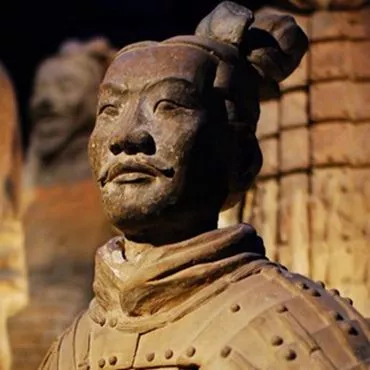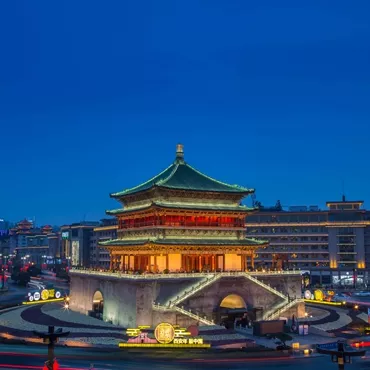Gao Family Courtyard
The Gao Family Courtyard, located at No. 144 Beiyuanmen Street in Xi’an, is a quintessential example of traditional residential architecture from the Guanzhong region and once served as the home of Gao Yuesong, a well-known gentry member during the late Qing Dynasty. The courtyard, nestled within the bustling city center of Xi’an, was initially constructed during the Chongzhen period of the Ming Dynasty. In 1966, it was nationalized, and in 1999, it became part of a joint Sino-Norwegian historical street protection project. Both nations invested in restoring severely damaged sections of the property. In 2001, the Xi’an city government listed the residence as part of the second batch of municipal-level key cultural relics protection sites. By 2002, it had earned the UNESCO Asia-Pacific Cultural Heritage Conservation Award. A year later, the Xi’an Chinese Painting Academy carried out extensive protective repairs, exploring and developing the site’s tourism potential, showcasing the building’s aesthetic, artistic, and cultural appeal to both domestic and international visitors.
Currently, visitors to the Gao Family Courtyard can enjoy exhibits that include Ming and Qing dynasty architecture, ancient furniture, traditional Chinese couplets, brick carvings, tea ceremonies, paper-cutting, shadow puppetry, guzheng performances, renowned calligraphy and painting works, old photographs, ceramics, and Shaanxi-style souvenirs.
"Home" Culture
In China, among the more famous ancient residences, most were built during or after the Qing Dynasty. The Gao Family Courtyard stands out because its main structure dates back to the Ming Dynasty, making it historically significant. Furthermore, unlike many ancient homes which are often located far from urban centers, the Gao Family Courtyard sits right in the heart of Xi’an, adding to its value.
The vitality of any tourist attraction lies in its uniqueness. While it may not possess the grandeur of the Wang Family Courtyard in Shanxi or the meticulous authenticity of Zhouzhuang in Jiangnan, the Gao Family Courtyard is unique as the residence of an official family in Xi’an. The stories of over 400 years are woven into its walls, providing a rich tapestry of history that gives depth to the concept of "home" culture. Following this idea, the courtyard was designed to reflect the everyday life of ordinary families in the Guanzhong region, evoking a sense of warmth and nostalgia, making visitors feel like they're visiting a neighbor from centuries past.
Since it’s meant to be a “home,” the experience goes beyond just viewing photographs and furniture. It requires living people and vibrant experiences to truly bring the past to life. Therefore, in addition to the usual aspects like architectural style, room layouts, and furniture displays, the entire visitor experience at the Gao Family Courtyard is highly interactive.
A Living Culture
The courtyard emphasizes the exploration of Guanzhong’s “living culture”—its rich folk traditions. As a result, visitors can not only learn about ancient architecture and lifestyles but also actively participate, enhancing the interactive nature of the visit. In March 2004, the celebrated shadow puppeteer Dang Fengju, a leading figure of the Heyang Shadow Puppetry, was invited to perform at the courtyard.
Shadow puppetry is an ancient and captivating form of Chinese folk theater, particularly popular in the Guanzhong region. Local masters of the art, known as "bashis," are highly skilled in their craft, capable of manipulating two or even three puppets simultaneously, recreating scenes of battle and action behind the screen. Accompanied by music and the beat of drums, these performances are vivid and mesmerizing. Dang Fengju, a master in her own right, learned shadow puppetry from her mother at a young age. She once led a troupe of over 40 performers throughout Shaanxi Province. After her troupe disbanded, she, along with two other puppeteers, was invited to give regular performances at the courtyard. Some of her popular performances include Selling Miscellaneous Goods, Borrowing Water, The Treasure Chest, The Funeral, and Carrying the Swallow. Foreign tourists are particularly fascinated by these shows, often staying after the performances to learn the art of manipulating the puppets themselves.
The Gao Family Courtyard consists of three sections running north and south. Currently, only the northern section and part of the southern section have been fully restored. Within the southern section lies an ancient stage that has inspired the developers to recreate the traditional family theater experience of prominent clans. They envision a vibrant cultural revival featuring local folk arts such as Qinqiang opera, shadow puppetry, puppet shows, and ancient musical and dance performances. This vision not only aligns with the courtyard’s status as a former official residence but also serves to showcase the folk customs of the Guanzhong region. A director from the Shaanxi Song and Dance Theater is assisting with the planning of the specific performances, with each nightly “family theater” event accommodating up to 280 guests. As the “family theater” concept takes shape, the overall design for the courtyard will fall into place. Centering on the themes of "home" and folk culture, the courtyard plans to launch a series of seasonal events, such as “Celebrate the New Year at the Gao Family Courtyard on the First Day of the Lunar New Year” and “Step Back 400 Years for the Lantern Festival.” When winter arrives, the courtyard’s teahouse will hang red lanterns and set up fire pits, inviting guests to sit by the fire with friends, sip tea, watch the snow, and enjoy a peaceful moment steeped in nostalgia within the enchanting atmosphere of the courtyard.















